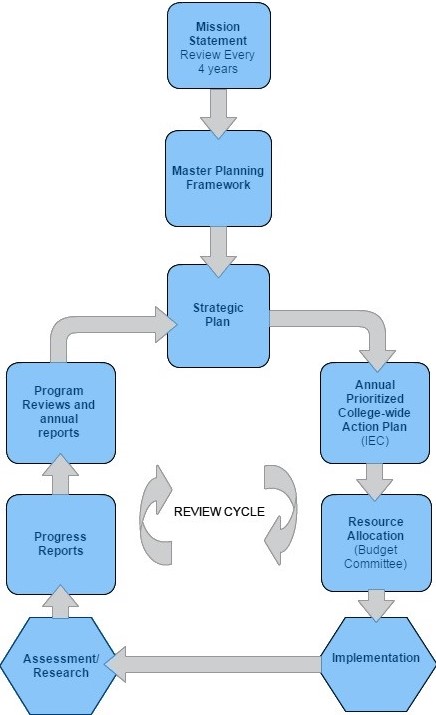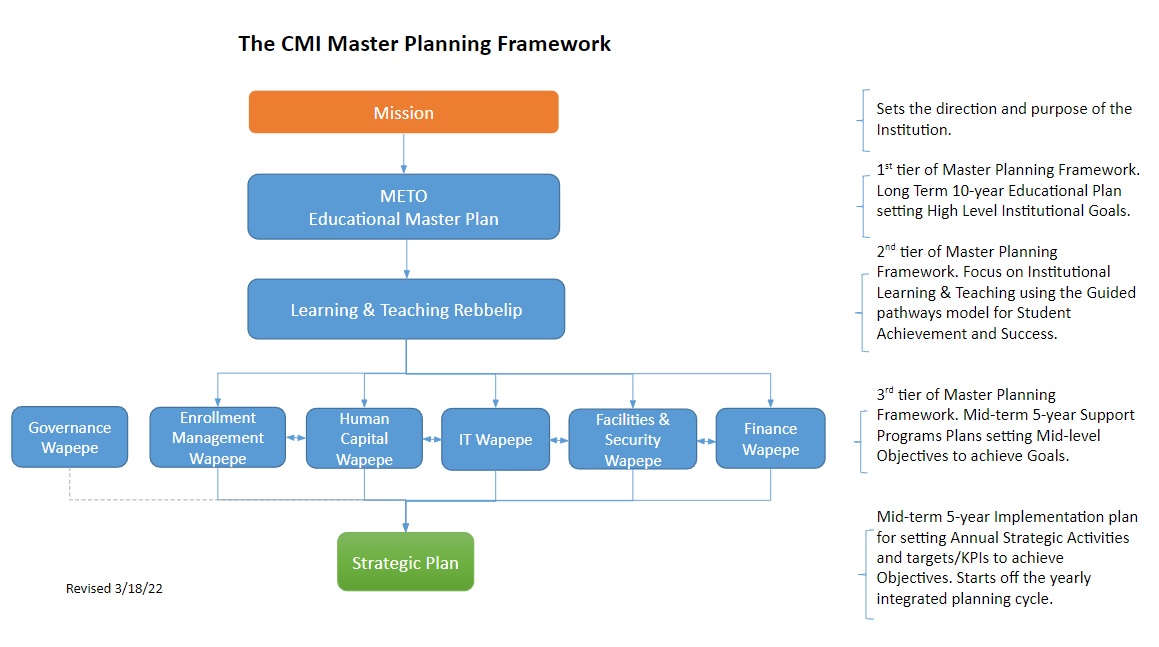CMI assesses its institutional effectiveness through planning practices that link to one another in a cycle of assessment and continuous quality improvement that is driven by the Mission of the College. As a cyclical process, integrated planning is expressed by the the diagram below showing College-wide integration of planned action, prioritization and allocation of resources, implementation, and research and assessment for continuous quality improvement illustrated by the FAIR(Framework and prioritization, Allocation of Resources, Implementation, Research and assessment) diagram below.

FAIR Illustration
The integrated planning process is described in more detail in the Integrated Planning Manual. The main elements of the Integrated Planning Process are described briefly below:

Integrated Planning Cycle
- The Mission Statement defines the role of the College in higher and continuing education and describes the intended student population. The Mission statement is the benchmark for measuring institutional effectiveness.
- The Master Planning Framework, also known as the CMI Planning Framework, is a long term planning framework with Institutional goals that are geared towards achievement of the Mission. The diagram below illustrates this planning framework.

Both an internal scan for effectiveness and an external scan for opportunities and threats are used to develop the Master Planning Framework.
The Master Planning Framework is wholly driven by the Mission of the College. The Mission drives the current 10-year Meto or Educational Master Plan which identifies the Colleges 5 long term goals – Student Achievement and Success, Expanded Access to Learning, Community and Economic Development, Sustainability of Fiscal, Physical and Human Resources, and Entrepreneurship. The Meto in turn drives the 5-year Wapepe plans that are currently under revision.
The Strategic Plan is a medium term plan with outcomes and activities from the long term Institutional Goals described in the Master Planning Framework. Timelines and Key Performance Indicators (KPIs) are developed and monitored in this plan to ensure the Master Planning Framework with its Institutional Goals, and ultimately the Mission of the college are carried out. The Program Reviews and the annual reports contain progress reports on the Strategic Plan and initiatives which are linked to the Strategic Plan goals and outcomes. These new initiatives are included in the prioritization process.
- The Annual Prioritized College-wide Action Plan is a summary of the activities within the Strategic Plan as well as initiatives resulting from the Program Reviews and Program Review Reports. A prioritization matrix establishes a criteria for scoring each planned activity/initiative as these compete for resource allocation. Activities to carry out essential functions will be prioritized at the departmental level.
- Resource Allocation includes both budget adjustments and the assignment of personnel to specific activities. Activities/Initiatives that have a higher score in the Annual Prioritized College-wide Action Plan are prioritized for funding and implementation (based on availability of resources). At the department level, activities to carry out essential functions are considered part of the operational budget therefore are allocated departmental resources.
- Implementation of activities and initiatives commence after resource allocation. Only the activities/initiatives that have been allocated resources will be implemented in any given year. Implementation planning will include a departmental work plan and an assessment plan for all activities and initiatives. The Performance Management System (PMS) ensures that activities and initiatives are carried out down to the individual personnel level.
- Assessment/Research is data-based and data-driven. It is essential to evaluating effectiveness in carrying out the mission at all levels – Institutional, committee, and departmental. Institutional Learning Outcomes (ILOs), Key Performance Indicators (KPIs), Administrative Unit Outcomes (AUOs), Program Learning Outcomes (PLOs), and Student Learning Outcomes (SLOs) will be assessed and reported on a regular cycle.
- Progress Reports inform the internal and external communities on progress toward longer term goals and shorter term outcomes, activities and initiatives as assessed. The Progress Reports on the Annual Prioritized College-wide Action Plan are produced quarterly by each department or unit. These progress reports inform the subsequent program reviews and annual reports.
- The Program Reviews and Annual Reports are assessment and planning documents which include the Strategic Plan activities. Each department at CMI is tasked with activities that derive from the Strategic Plan, and annual reports assess effectiveness in achieving its programmatic activities as well as the targets and KPIs set in the Strategic Plan. The President will compile an annual report that also includes a summary progress report on the Strategic Plan each year which is based on the KPIs for each Goal, as well as the Institutional KPIs. Program Reviews may include new initiatives that will be linked to the Strategic Plan goals and objectives.
Original integrated planning manual was approved in September 2016September 21, 2016
Recommended revision by IEC October 14, 2020
Revision 1 approved by EC December 02, 2020

